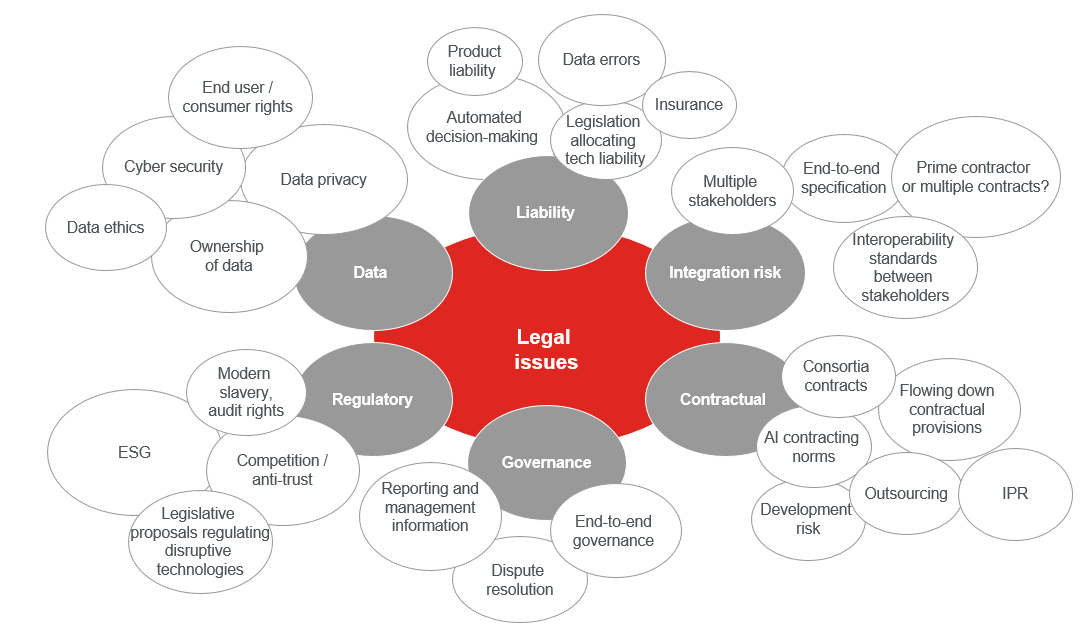
A smarter choice? Technology solutions for supply chain management
Global | Publication | maart 2021
As with business operations in general, supply chains are currently undergoing transformation arising from digitalisation and the adoption of disruptive technologies such as the internet of things (IoT), blockchains and distributed ledger technology (DLT), cryptocurrencies, smart contracts, artificial intelligence (AI) and autonomous vehicles (AVs).
Uptake of these technologies has been given a further impetus with the COVID-19 pandemic, which has significantly increased the importance of supply chain visibility and management to the success, and even viability, of businesses in many industries.
What this briefing covers
This briefing:
- Examines the potential role of various disruptive technologies in a business’s supply chain.
- Considers key legal factors in digitalising supply chain processes through the implementation of such disruptive technologies.
What is the role of disruptive technologies in supply chains?
Tracking
For physical goods, the deployment of IoT – individual devices and sensors that have internet addresses and connections – means that changes in the physical location of goods can be monitored in real-time or very close to real-time.
Case study: Home deliveries
It is now commonplace in developed countries for residential consumers to track parcel deliveries through the use of bar codes on packages and internet-connected scanners monitoring changes in location or custody of the packages.
For more information on IoT, see our hub Internet of things.
Data
IoT devices generate a great deal of data. In supply chains with high-value consignments, it is a small step conceptually for the participants to consider sharing the data they jointly need for business processes about consignments on a single shared data platform.
Private DLT platforms have become the means for multiple participants to share commercial data in a tamper-proof way.
Case study: VAKT
The VAKT platform uses a distributed ledger to share data between major energy suppliers and distributers, banks and commodities traders for management of energy supply logistics.
The shared data platform eliminates the need for data reconciliation between participants.
For more information on DLT, see our hub Distributed ledger technology.
Automated processes
Distributed ledgers enable the creation of automated software programs, called smart contracts, which can execute inter-company business processes that use the shared data.
Case study: Exporting and importing goods
In the supply of goods from an exporting country to an importing country, the release of the goods from customs controls by the exporting country can lead to an automated notification via a smart contract to all the relevant stakeholders that the goods are now ready for on-boarding to a ship taking them abroad.
The stakeholders here can include the suppliers and receivers of the goods, any distributors and brokers in between them, as well as banks financing the trade, insurers and regulators.
For more information on smart contracts, see our hub Smart contracts.
Artificial intelligence
Although automated, programs such as smart contracts are usually not very sophisticated. Having a shared data platform, however, provides potential for more intelligent software to operate, such as the machine learning algorithms running over large data sets now being deployed in most industries.
Such AI programs may be used to:
- Identify trends and correlations; and
- Predict logistical bottlenecks and hiccups, and similar supply and demand mis-matches along supply chains.
Accurate predictions
Accurate predictions can be of great benefit to human managers responsible for effective supply chain operations, for example in:
- Forecasting.
- Finding alternative sources of supply.
- Remediating bottlenecks.
- Ensuring the smooth running of logistics processes.
For more information on artificial intelligence, see our hub Artificial intelligence.
Self-managing supply chains
Over time, and using more sophisticated AI programs, known as self-managing or self-* systems, we may even have software with the capability to manage supply chains without human intervention.
While this is possible now for simple systems, for complex supply chains with many participants we are several years away from achieving this vision. However, the COVID-19 pandemic is likely to increase and hasten investment in logistics technologies leading towards the realization of this vision.
Dashboards
Executives responsible for supply chain management require the ability to see both along a chain, and also to delve vertically into it – that is, to be able to view the past and future progress of shipments and also to view the current status of a particular shipment or item. Dashboard systems, which allow real-time visibility across and down into a chain, as well as the ability to intervene when appropriate, are increasingly important for successful management of supply.
Just-in-time to just-in-case logistics management
The COVID-19 pandemic has led to a major shift in supply chain and inventory management in global enterprises from an extreme focus on operational efficiency to a recognition of the need for redundancy and spare capacity. Some have called this a movement away from just-in-time towards just-in-case logistics management.
Supply chain audits
Initial reactions to the pandemic were of necessity made quickly and under time pressure. However, as businesses devote time and resources to re-imagine their supply chain structures and processes, a key element will be taking stock of current systems and processes and assessing how close (or how far) these are from the vision outlined above.
Such supply chain audits need to combine deep understanding of these emerging technologies and the possibilities they enable with awareness of regulatory requirements regarding the provenance and supply of goods and services (for example, modern anti-slavery laws), together with an understanding of the many legal and contractual issues involved in supply, distribution and outsourcing.
For more information on supply chain audits, see our website page Technology Consulting.
What are the key legal factors?
What are the key legal factors in digitalising supply chain processes through the acquisition of disruptive technologies?
To answer that question, it is first necessary to understand some of the challenges that come with these technologies. Businesses will need to factor challenges such as the following into the risk profile of a supply chain project (and the contract documentation and risk mitigation processes relating to the project:
- What are the implementation challenges?
- What are the challenges to uptake?
Each of these is considered in what follows.
Technology and implementation challenges
Taking DLT as a case study, what are the challenges such a technology gives rise to for a business in terms of implementation? The following are key considerations:
DLT still immature as a technology
- For example, lack of software engineering tools
- Lack of design patterns
- Systems not yet scalable
- Communications between platforms
Implementation challenges
- Organisational challenges for consortia
- Data privacy vs. data sharing
- Integration with legacy systems
- User-friendly interfaces
Management of crypto-keys
- Most DLT systems use public-key infrastructure
- Who controls these?
- Issues of secure custody, storage and backup of keys
- Insurance of keys against loss and theft
Challenges to uptake
Many disruptive technologies also give rise to a number of wider challenges for businesses as a whole. These may not directly impact on a business itself but still need to be taken into account. For example, the business will need to consider the impact on consumer rights (in the case of B2C supply chains), the needs of other stakeholders (including their own regulatory requirements in relation to supply chains), and accessibility of the relevant technology platform by others in the supply chain.
Here are some of the key challenges to uptake of such technologies:
Potential risks
Scalability
- Market acceptance to necessary objectives
- Trust in the system by participants necessary
Adoption risks
- Interaction with legacy infrastructure
- Cyber security risks not eliminated by DLT and common standards necessary for success
Risk allocation
- Responsibility for platform risk allocation when information is on DLT (data loss / corruption)
Legal uncertainty
- Application of existing principles to the new technology - new risks
- Cross-border operation
Regulation
- Application of existing regulatory framework for regulated industries
- New regulations?
What are the key legal issues in a supply chain context?
We have considered the key legal risks associated with particular disruptive technologies in detail elsewhere, and do not repeat that analysis here. For present purposes, set out below is a summary of the key legal risks that are common to disruptive technologies when looked at through the lens of implementation within a supply chain solution:

What are the legal issues for particular disruptive technologies?
For more information on the key legal issues associated with particular disruptive technologies, see our various information hubs:

The future of supply chains
Subscribe and stay up to date with the latest legal news, information and events . . .

